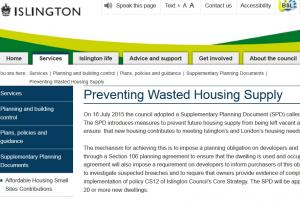



As of 17th July 2015, the London Borough of Islington has introduced an innovative new planning policy aimed at tackling the so-called "buy-to-leave" phenomenon. Islington's approach relies on a Supplementary Planning Document entitled "Preventing Wasted Housing Supply". This will require developers to sign a "Section 106" agreement [S106][1] aimed at ensuring that homes are occupied after they are completed: effectively the agreement cascades down to individual owners as the S106 obligations run with the land as a land charge. The developer is required to inform the new owners of the obligations as part of the marketing.
Trail-blazing
The new measure is the first of its kind anywhere in the country and was introduced after extensive consultation and a significant amount of research into the incidence of the problem. Perhaps surprisingly the opposition from developers during the consultation was muted, with only two responses to each of the formal consultation exercises. However the longer one, provided by Savills, suggested that the measure was ultra vires and it may well be that a challenge will be mounted via the courts; and if not via a planning appeal in relation to a new development. The GLA welcomed the intent of the measure.
The government too has been keen to be seen to be tackling the worst excesses of buy-to-leave and it will be interesting to see what the response will be to this initiative.
Summary
The Council's Adoption Statement sums up the measure as follows:
The purpose of the SPD is to prevent future housing supply from being left vacant and, in effect, “wasted”. The mechanism for achieving this is to impose a planning obligation on developers and purchasers of newly built housing through a section 106 planning agreement to ensure that the dwelling is used and occupied for residential purposes. The agreement will also impose a requirement on developers to inform purchasers of
this obligation. The Council will have the right to investigate suspected breaches and to require that owners provide evidence of compliance. The SPD supports the implementation of policy CS12 of Islington Council’s Core Strategy. The SPD will be applied to all developments that result in 20 or more new dwellings. The SPD provides considerable evidence as to the extent of the problem. Key requirements The SPD requires
this obligation. The Council will have the right to investigate suspected breaches and to require that owners provide evidence of compliance. The SPD supports the implementation of policy CS12 of Islington Council’s Core Strategy. The SPD will be applied to all developments that result in 20 or more new dwellings. The SPD provides considerable evidence as to the extent of the problem. Key requirements The SPD requires
- that properties are not left empty for longer than 3 months at any one time
- that they must be occupied for at least 14 days in any period of 3 months
- Tenancy agreement for more than 3 months together with evidence that the tenants are paying council tax.
- Evidence that persons use the address for registration for (GP, hospital or similar) education (nursery, primary, secondary or further) social services, church electoral roll or other similar.
- Persons living at the property registered with that address the electoral roll.
- Evidence of the consumption of power consistent with the required level of occupation (for example utility bills etc.)
- Records kept by the freehold owner and/or head leasehold of the building (for example records kept by the concierge deliveries to and collections from the dwelling and any other verifiable records.)
- Other verifiable evidence.
